Quibi’s Little Stories Just Might be Something Really Big!

Three years ago, Jeff Katzenberg sold DreamWorks animation to NBCUniversal for $3.8B and sorta’ fell off the M&E industry radar.
A year later, he was back in the news with a new approach to entertaining folks with professionally produced short films (mini episodic documentaries, thrillers, comedies, musicals, sci-fi, anything/everything but in 10-minute or less chunks). He was convincing because he:
- Talked Meg Whitman into leaving HP for his start-up docuseries, musicals, mini-mystery,
- Convinced Warner Bros, Disney, MGM, Sony Pictures, 21st Century Fox, NBCUniversal, Liberty and others to invest $2B
- Has project commitments from Chris Rock, Justin Timberlake, Lena Waithe, Antoine Fuqua and a long star-studded Hollywood cast to create short-form content
- Has had “serious” discussions with every major service and smartphone provider
All of the other content producers, distributors and their sisters are rushing to fill their inventories with more big (and expensive) films and episodic series to compete against Netflix and each other for the millions of long-form entertainment hungry folks around the world.
Katzenberg’s vision is far from modest. He plans to create a whole new species of entertainment targeting Gen Zs, 18- to 34-year-olds with short-form video series produced with budgets and production values you expect to see on primetime TV, along with top-shelf creatives on both sides of the camera.
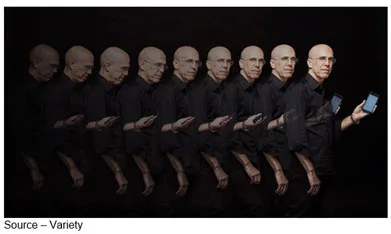
You know, dramas like Empire, Scandal, FBI, NCIS but delivered in 10-minute episodes made for mobile consumption. Then too, a five-minute talk show, or a two-minute newscast — all with high-profile talent.
The explosion of short-form video is obvious to Katzenberg who notes that YouTube accounts for 35 percent of the global mobile internet traffic.
But it has nearly all been produced by amateurs – user-generated content – and he is pretty sure taking a professional approach is now what the increasingly sophisticated smartphone user wants and expects.
While smartphone sales have stagnated in recent years, Statista estimates that over 36 percent of the world’s population has a smartphone and that there will be more than 2.87B smartphone users worldwide by next year. Mobile users worldwide will increase to 5.5B within the next five years.
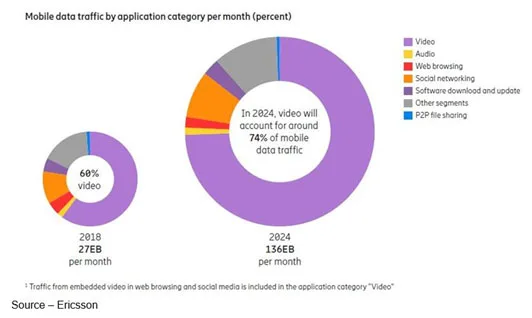
According to Ericsson, nearly 75 percent of the mobile traffic will be video.
So why does Katzenberg feel the time is right for professionally produced short form video content?
Probably because of our shrinking attention span.
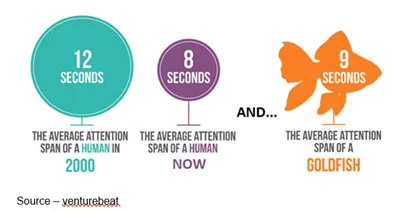
According to a Microsoft report, the average human attention span has shrunk from 12 second in 2000 to eight seconds in 2018. That’s shorter than the notoriously distractible goldfish and some anthropologists wonder if the human attention span might be on its way to zero.
There’s no need to panic quite yet because an article in The American Electrician in 1897 worried that our growing dependence on the telephone would turn us into “transparent heaps of jelly” and that hasn’t quite happened … yet.
However, the idea that our close bond to our smartphones, even when they aren’t being used, could be a mild form of addiction.
But rather than focus on all smartphone users, Katzenberg and all content producers/distributors need to focus on the Gen Zers.
Those folks born between 1995 and 2015 represent the largest cohort by number of any generation alive. They are on track to become the largest generation worldwide (32 percent of 7.7B people).
The smartphone isn’t just a tool to them, it’s an integral part of who they are, what they do even when they’re not using it … it’s just there.
Gen Zers are always on, and one of the main things they are using their devices for is video.

Nearly half spend nearly three hours daily with video channels like YouTube and the new TikTok.
A study by AwesomenessTV noted that 71 percent of their entertainment is streaming and that they watch nearly 70 videos a day.

According to Nielsen, more than 168 million users accessed video on their smartphone in the last quarter. While TV still has greater reach, smartphone viewing still outstrips computer or DVD viewing. Smartphone apps consume more user time than streaming video.
One of Jeffery Katzenberg’s many goals is to bring together great TV viewing and short-form video on the smartphone, so it becomes a major source of news and entertainment for people across the generational spectrum.
Fortunately, we know a few indie filmmakers who have actually make short episodic content, so we asked them.
We bumped into Chris and Nicole Sobchack, aka Wraptastic Productions, a couple of years ago at Sundance where they premiered their 8-pisode comedy, “Please Tell Me I’m Adopted!” that has been widely viewed in more than 20 countries on Amazon. A second season is scheduled for release late this year.
A lot of people who binged season 1 wanted season 2 right away but that’s a little tough when both Nikki and Chris wear so many hats. Nikki was working on the scripts, celebrity cameos, masterminding social media for the show, co-writing her first feature, and following her biggest passion as a working actress. Chris was flying around the globe handling his drum & percussion tech duties for Elton John while working on the pre-production for both the series their feature film debut, Lore Harbour.
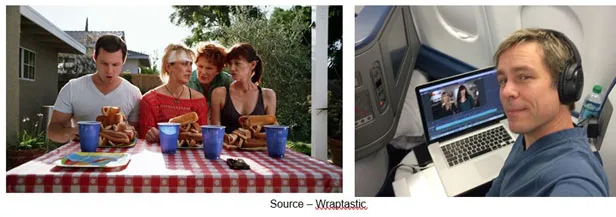
They’re keeping the new storylines and cast under wraps; but in the first series, they were honored to have Marion Ross, of “Happy Days” fame, star as the Mother of two of the leads in addition to a stellar supporting cast.
“Casting is critical,” Nikki emphasized. “You need people who are like family and will help you sell and promote the project. Short-form episodics are a new art form that appeals to a young, hip, connected crowd; so you need tastemakers who can bring social media attention. To access traditional media, you need recognizable celebrities to get the mainstream publicity.
“Each episode has to be a story idea that you can finish but will also support the series as a whole,” she continued. “Short-form episodics are a combination of a sitcom and Adult Swim style sketch comedy. Since it’s short content, it has to stand on its own against the funny cat, dumb kid stuff that floods the internet. The great thing is people appreciate great content when they see it and they want more regardless of length.”
Chris emphasized that small budgets and short shoots put pressure on the cast and crew for time spent and footage shot. “In a comedy series, you need the reaction shots to sell the jokes,” he noted. “In season 1, Nikki actually repurposed shots from the trash and was glad we kept the camera rolling during outtakes to fill in gaps in our footage.
“You break rules all the time,” he added. “There’s no long establishing shots. The viewer wants a fast, tight show header and credit roll because they want to focus on the story, get in, get out and move on. There is literally no time to waste!”
Chris emphasized that knowledge is power when you’re on the clock and it’s your clock and your limited resources. “The piece may be short,” he noted, “but you have to give your team the time necessary to get everything done.”
Chris learned every step of the post process and even learned tricks the developers didn’t know could be done with the Blackmagic tools. However, while it’s tempting to say, we’ll fix it in post, he found it’s much better to spend time in pre-production to do it right the first time on the day of the shoot.
“Fixing footage at 30,000 feet or in a hotel room is a real pain,” he said. “With these lessons learned, we’re working hard on season 2 to shoot what we need properly and be set up for a quick post assembly.”
Nikki agreed and emphasized that short-form episodics are developing a nice niche. “Imagine you’re on a long flight to somewhere, you’ve watched a 2.5-hour film, an episode of your favorite hour procedural episodic and you have 15 minutes until landing. Now you’ll have something to watch before you land! Please Tell Me I’m Adopted!”
VR Episodic
We’ve watched VR (Virtual Reality) grow from a fun curiosity into a wide-ranging informational, educational, entertainment solution over the past four years to the point where it is widely accepted by professionals, filmmakers and viewers.
But what really convinced us was the Doug Liman’s (The Bourne Journey) release of a VR episodic series, Invisible, that was done by Lewis Smithingham, of 30 Ninjas.
Invisible broke a lot of new ground for VR filmmaking and Lewis and his team had to develop a lot of the hardware and software tools for the project, which have since been refined and are standard fare for the RV filmmaker. If you haven’t seen it, grab an HMD (head-mounted display) and enjoy, http://tinyurl.com/y68m6mr6.
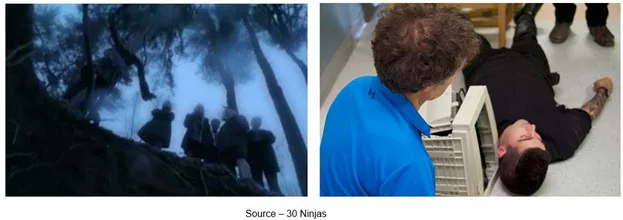
“Invisible broke new ground and established new rules,” Smithingham said. “It proved you can script a VR storyline and give the viewer audio/visual cues to guide him/her through the story. Tolerance for editing is directly related to the quality of storytelling but it isn’t easy, even with the improved and advanced tools we have now. Even now, there are things that happen in Invisible you don’t see in other VR series. Fast editing, action, immersive lighting and parallel editing are things folks are comfortable with today.”
For the project, Liman gave Smithingham the freedom to break all the established VR guidelines and define new rules that would deliver something new, different and refreshing for the viewer. Because of the constant iteration, the shooting schedule was 25 days over 7 months.
Smithingham explained that in the VR universe people are able to look in any direction, which can be a little disorienting but that Liman and he had developed new ways to guide the viewers gaze/experience using sounds, images and transitions throughout the film.
The series is set in modern-day Manhattan where the dynastic Ashland family has passed on a gene that gives them an extraordinary ability to accumulate vast amounts of power and wealth until the “unique ability” is threatened to be exposed.
Lewis noted that “standard” techniques are still being developed as people like Andrew Shulkind, Andy Cochrane and 30 Ninjas keep pushing the envelope on the technology, what it can do and what VR filmmakers can do.
“We’re increasingly blending VR, AR and MR as well as delving into volumetric production, which is opening up breathtaking new opportunities for viewer involvement and interaction,” he said. “Invisible has stood the test of time and it is still a series of VR shorts that people enjoy visiting again and again; but in the next few years, we will take people to a new environment, a new world that they couldn’t imagine–even in their wildest dreams.
“It’s awesome and will be even more exciting and immersive for people who experience it,” he said. “It’s a dimension beyond dimensions and I think it’s going to be the go-to place for people that short-form episodics will enable them to visit for 10 minutes, return to the real world and then jump back in to a new experience or continue on the path they were on before. If you liked Ready Player One, which was great to watch tomorrow’s VR and volumetrics, will deliver all of that and more.”
We’re not sure about you, but we’re looking forward to experiencing the new work…10 minutes at a time!
Rethinking Ads
The combination of fast, condensed storylines, a shorter attention span and a continued interest in free content have made channel partners and marketers rethink the design and flow of ads to make them effective.
According to the IAB (Interactive Advertising Bureau), firms that approach their marketing efforts as mobile first to reach the influential Gen Zers, often find it difficult to give up the use of long-form advertising in the new short-form space.
Heck, it’s even difficult to watch the “traditional” 30-second or one-minute ad on TV – even during the Super Bowl – and with mobile first marketing, it becomes even more difficult.
When he first advanced the idea of 6-10 second ads to client Twain Richardson, head of FoR (Frame of Reference) post production in Jamaica, he said they thought he might have been partying too much.
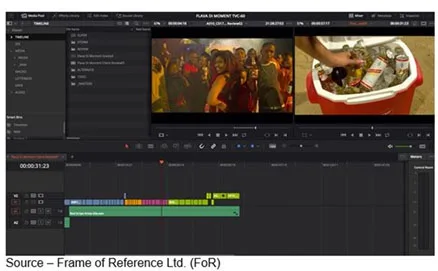
“Clients are surprised that 6 to10 seconds is enough to get a powerful message across,” Richardson said. “Once you divide the time into images, people quickly realize that it was enough time to say something even bigger.
“Our brains really aren’t time-constrained, he added.
“The biggest surprise was honestly the fact that six seconds really is enough time to get a big message across. When I was writing and thinking in words, it was hard to keep the narrative small enough; but once I divided the time into images, it felt like there really was enough time to say something bigger.”
Andrew Lee, of Ralph Smyth Entertainment in Austin, TX, not only did a six-part series of branded cooking videos for the Texas Beef Council but developed a mobile-ready ad that has drawn praise from the council and attention from mobile viewers everywhere.
The series featured local personality Jess Pryles and her Hardcore Carnivore brand shirts discussing the enjoyment of meat lovers cooking beef on their grills.

Instead of an extended cooking story for the ultra-short-form ad, Lee focus on two scenes – the sizzling steak on a hot grill and Ms. Pryles talking about the great taste wearing her special “Steak & Bourbon…a complete meal” shirt.
In addition to the favorable comments for the spots and ad, Ms. Pryles said hardcorecarnivore.com has enjoyed a lot of visitors … and sales.
“We were surprised by the power of a few images and how quickly the mind could fill in the blanks,” Lee noted. “But in only six-seconds, 180 frames people have said the ad was very effective and feels much longer.”
“The key,” Richardson added, “is to spark images in the viewer’s mind and make him/her want to see more. And it certainly can’t be on-screen so long that people want to move to another short-form video.”
Whether it’s a short-form film or a series for Quibi, Amazon, YouTube or other mobile streaming services; the story must be interesting and done very professionally.
If the horizontal or vertical video is to be viewed free (ad supported), it requires the best message you can give the viewer … they can see the difference.

Just remember what Liane Moriarty said, “Little kids, little problems. Wait till you’ve got drugs and sex and social media to worry about.”
Viewers can tell the difference immediately and if you can’t grab them instantly, they’re … gone!
# # #